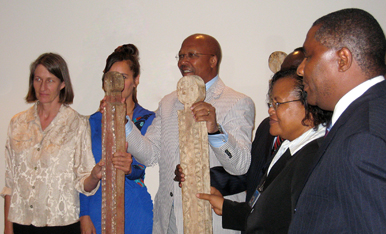Sending History Home
APARC Director Charles Stith brokers return of African artifacts to Kenya

For decades, burial statues looted from the grave sites of the Mijikenda people of Kenya have been sold to art collectors in America and Europe. The statues, carved wooden slats that are between four and six feet tall, are sacred to the villagers, who believe that bad luck, sickness, crop failure, and even death befall families whose memorial totems have been stolen.
Recently, Charles Stith, director of the African Presidential Archives and Research Center (APARC) at Boston University and a former U.S. ambassador to Tanzania, took a step toward restoring the good fortune of these families. Stith brokered a deal to return nine totems, called vigango, to Kenya; in a ceremony at the United Nations on June 25, he turned them over to the Kenyan government, which plans to reunite the totems with their owners.
“From the perspective of the country, it is a return of the patrimony of the country,” says Stith. “For the families, it is a way of making the family whole. The totems are very important because not only do they commemorate the life and death of a loved one, but they also connect the family to its past.”
The Kenyan government will display the totems in the Nairobi Museum and post an announcement encouraging families who have lost them to come forward. “Seeking the return of vigango totems and other stolen African artifacts to their rightful owners in various nations of Africa demonstrates our appreciation for art and culture,” says Peter Ogego, the Kenyan ambassador to the United States, who accepted the totems. “The return of the vigango reflects our mutual obligation and commitment to protect and conserve the rich diversity of African culture and heritage for the benefit of all humanity.”
The nine totems belonged to the late Broadway producer Lewis M. Allen and his screenwriter wife, Jay Presson Allen. It is believed that the Allens did not know the artifacts were stolen when they bought them while traveling in Africa more than 20 years ago. When their daughter, Brooke Allen, decided to sell her parents’ art collection, including the vigango, which can fetch up to $10,000 apiece on the open market, Connecticut art dealer Kelly Gingras realized their significance.
Gingras and Allen tried unsuccessfully for months to contact the Kenyan government about the totems. It was not until they connected with Stith that the process of returning the artifacts began.
“Ambassador Stith and APARC were essential in making the handover of the vigango possible,” says Gingras. “This is the first time a gallery, collector, or private dealer has willingly returned vigango to Kenya.”
According to Stith, Interpol, the International Criminal Police Organization, estimates the trade in illegally acquired African artifacts amounts to a half-billion dollars a year. He notes that it is unusual for an art dealer or collector to return looted African artifacts voluntarily.
“There was a great deal of appreciation on the part of the Kenyans,” says Stith, “and a great sense of pride and relief on the part of Brooke Allen that she was able to close the loop and return these sacred items.”
Meghan Noé can be reached at mdorney@bu.edu.